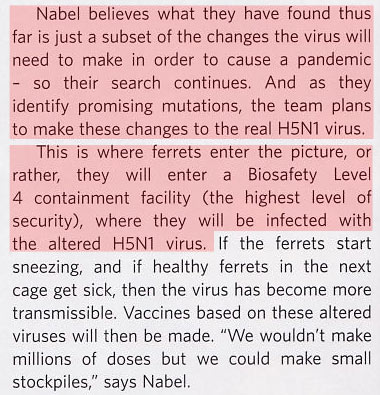U.S. Researchers Trying to Create Pandemic Avian Flu
March 1st, 2008Cosmos
Issue 18
December 07/January 08
Pages 36 and 37
Here’s an excerpt:

Now that Gary Nabel, Director of the Vaccine Research Center at the National Institute of Allergy and Infectious Diseases, admits that his team is trying to engineer a pandemic strain of the H5N1 virus, here is some additional information to consider:
Health Minister of Indonesia: U.S. May Turn Avian Flu Into Bioweapon
The New PSYOP Payload: Bird Flu and the Collapse of the Internet
Bird Flu “Pandemic” Antidote: Wash Hands
Spanish Agriculture Minister: Bird Flu Sparking Human Epidemic Is “Science Fiction”
STRATFOR on Bird Flu: Calm Down
Flu Pandemic: New Zealand’s Martial Law Contingency Plan
U.S. Military Begins Planning for Avian Flu Pandemic
Finally, with U.S. scientists engineering pandemic strains of influenza and infecting animals that need to be kept in a level 4 biosafety containment facility, I suppose that it’s just a coincidence that British media is out with warnings about the increasing threat of animals spreading diseases to humans.
Metro: Health Risks from Animals Increasing:
Infectious diseases such as Ebola and Sars which spread from animals are an increasing threat to human health – but conservation of wildlife-rich areas could help prevent their emergence, scientists have said.
Around two-thirds of emerging infectious diseases come from animals and 71.8% of those come from wildlife, a study published in the journal Nature said.
Researchers from the Zoological Society of London (ZSL), University of Georgia, the Consortium for Conservation Medicine and Columbia University said new infectious diseases were on the rise.
The scientists analysed 335 incidents of disease emergence between 1940 and 2004 and found they had risen significantly in that time.
And they said zoonoses – diseases that originate in animals – were an increasing and very significant threat to global health.
and…
Telegraph: Britain Is Hotspot of New Germs Says New Study:
“We are crowding wildlife into ever-smaller areas, and human population is increasing,” said coauthor Prof Marc Levy, a global-change expert at the Centre for International Earth Science Network. “Where those two things meet, that is a recipe for something crossing over.”
Some pathogens may be picked up by hunting or accidental means; others, such as Nipah virus, which recently emerged in Malaysia, go from wildlife to livestock, and then to people.
Humans have evolved no resistance to zoonoses, so the ailments can be extraordinarily lethal. The scientists say that the more wild species in an area, the more pathogen varieties they may harbour.
Research Credit: IL and HT

Fill it to the rim…with grim!